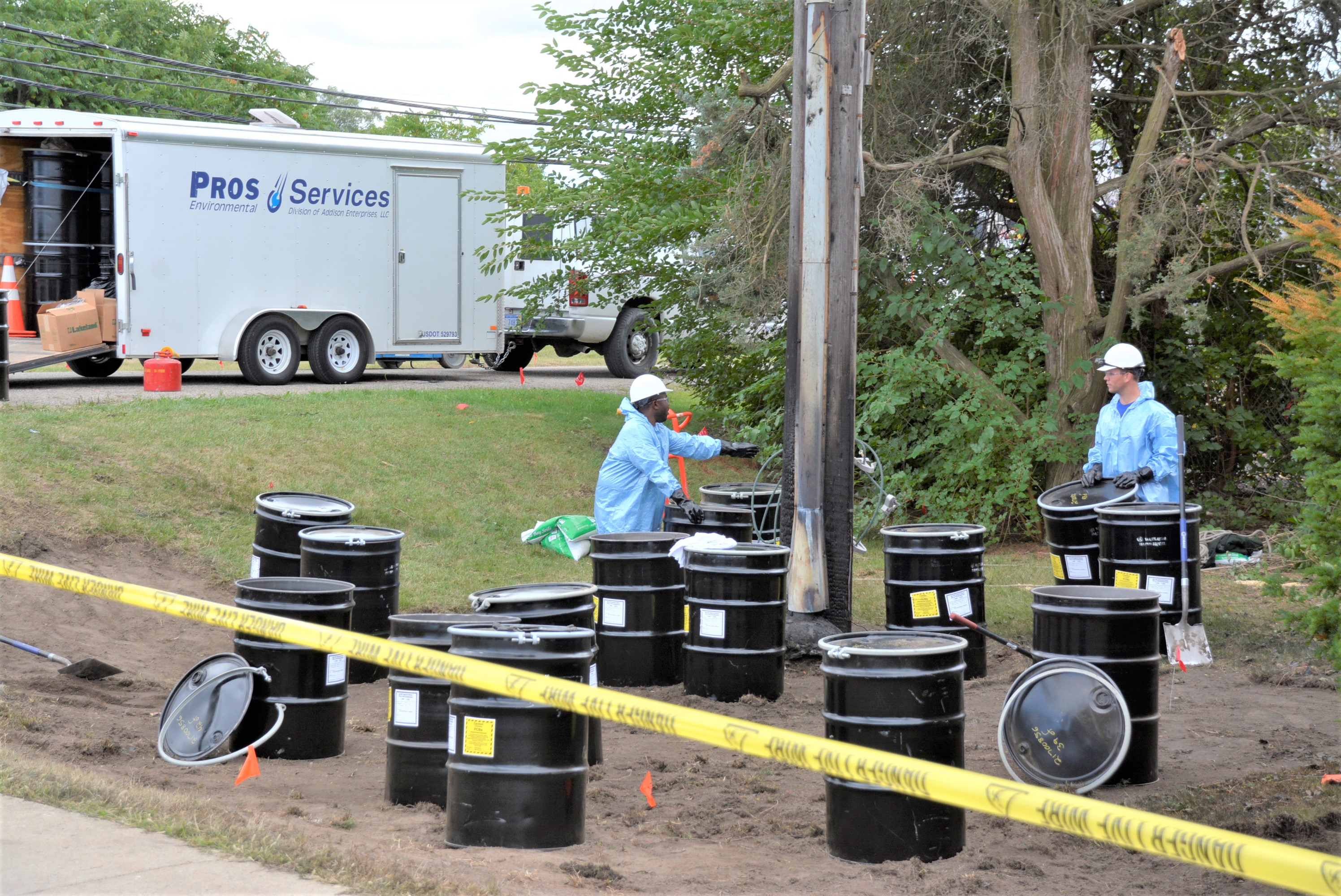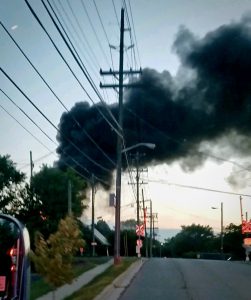Contamination suspected at fire site

Friday afternoon, workers in protective gear clean up debris at the site of the fire and shoveled it into sealed barrels clearly labeled as containing PCB, a known carcinogen. Photo by Dave Willett
Aug. 25, 2017 PLYMOUTH EAGLE.
Plymouth Michigan News
Don Howard
Staff Writer
Concerns about possible toxic exposure have prompted local fire department officials to order testing of firefighters’ gear for carcinogens after a fire last Wednesday at a DTE Energy sub-station next door to the Plymouth Cultural Center on Farmer Street.
The gear will be tested for polychlorinated biphenyls (PCB) which the Environmental Protection Agency has classified as a probable human carcinogen.

The fire left 4,000 city residents and businesses without power, some only restored in the early morning hours Friday as DTE crews worked round-the-clock. Power to downtown businesses on both Main and Forest streets was interrupted until Friday morning, grinding downtown business to a standstill.
Firefighters from Northville-Plymouth, Plymouth Township and Northville Township, including a Western Wayne County Fire Department Haz-Mat team, were dispatched about 8:30 p.m. Sept. 16, after numerous callers reported hearing popping noises and then observing heavy black smoke and flames shooting from the area of the brick, slate-tiled building that adjoins a large structure of beams and transformers. The sub-station is owned by DTE Energy and functions to regulate voltage for an estimated 4,000 homes and businesses in the city.
According to DTE Executive Director Distribution Operations Ryan Stow, the substation, which now must be totally rebuilt, contained transformers, protection and control equipment and circuit breakers to interrupt any short circuits or overload conditions that occur in the network.
Stow was reticent to give specifics about the fire or the size and character of the electrical equipment stating, “It was a failure in the sub-station the led to the noise people heard.” His only comment as to the cause of the fire, which he said is still under investigation, was that the fire was “not related to an over- load” and could have been caused by “animal interference–like a squirrel.”
Numerous fire-related incidents like the one at the Plymouth substation involving electrical equipment can contain polychlorinated biphenyls (PCB) and are known to result in widespread contamination of buildings and structures, according to the National Institute for Occupation Safety and Health (NIOSH). Stowe said he “didn’t know” if the sub-station transformers or equipment contained PCB, but added DTE changed out the oil and the transformers over the years.

Friday morning, however, workers dressed in protective gear were shoveling the heavy ash and oil-soaked debris from the site of the fire into black, 50-gallon sealed drums clearly labeled as containing PCB, apparently for hazardous waste disposal.
According to industry experts and leading fire professionals, PCB is considered a toxic chemical with residual characteristics. It was mainly found in insulating fluids (oil) in heavy-duty electrical equipment and transformers in power plants installed since the late 1920s. It is used mainly because of stability at high temperatures.
The Environmental Protection Agency (EPA) banned manufacturing of PCB in the U.S. in 1979 and immediately established controlled waste disposal regulations. Waste containing PCB must be destroyed by incineration or disposed in approved landfills. It is said to be bio-accumulative and not biodegradable. PCB exposure can lead to adverse health effects, according to the EPA. The non-flammable synthetic chemicals are still used as coolants and lubricants in electrical equipment even though the chemical is no longer manufactured in the U.S.
Aerial video footage taken at the fire shows enormous raging flames and a huge plume of thick black smoke billowing-up in mushroom clouds from a large transformer directly at the rear of the building. Firefighters said the smoke is a characteristic of burning oil. One informed firefighter said the transformers could have contained more than 1,000 gallons of contaminated cooling oil.
Plymouth Township Fire Chief Dan Phillips said he was informed the oil in the transformers had been changed several times during the years but said he was being cautious about the reported risks of increased toxicity. He said rumors that the attending firefighters gear was to be destroyed and burned was “a half-truth.” He added that PCB is destroyed in temperatures higher than 1,000 degrees, and that the heavy black smoke was a sign of incomplete combustion.
Phillips said the fire department gave “some” firefighter gear to DTE to test for the dangerous particulates and if the gear is safe, it will be cleaned and returned to service.
“We are taking an over-abundance of caution to make sure everyone is safe,” he said.
Plymouth City Manager Paul Sincock described the performance and response by area fire department personnel at the fire as “phenomenal.”
Witnesses said firefighters soaked the cultural center to prevent any sparks or flying debris to ignite at that building while continuing to battle the flames and smoke at the burning sub-station.
Phillips said he was equally pleased with the outcome and the performance of the firefighters.
“The (fire) departments did a great job containing the fire, protecting the cultural center and saving the sub-station building,” Phillips said.
Plymouth Voice.
Video by Brett Lyon



